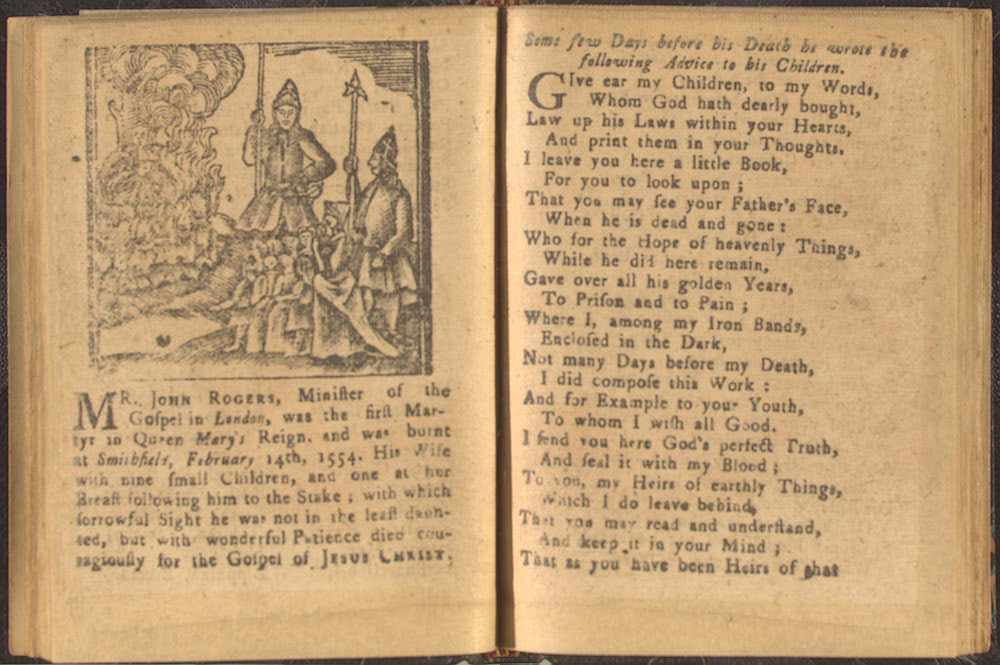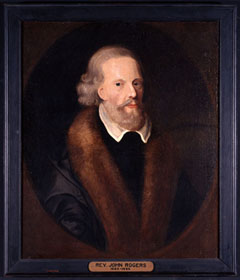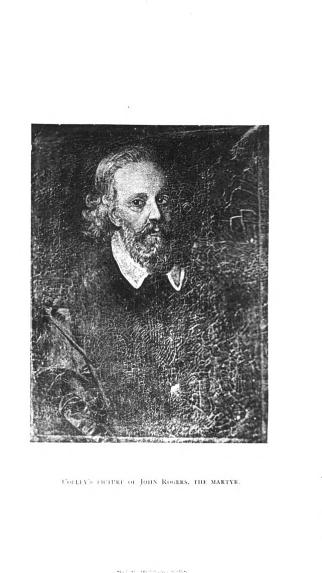Biography - John Rogers Society

Rogers left behind a name which ought to be held in honour by all Protestant Churchmen as long as the world stands. (Bishop J. C. Ryle, Light From Old Times, 1903, 4th ed., p. 64.)

John Rogers Portrait and versified speech to his children, The New-England Primer Improved, Boston: A. Ellison, 1773.

JOHN ROGERS (1505-55), 1805
Samuel Harris (1783-1810)
after John Singleton Copley (1738-1815)
oil on canvas
30 1/2 x 25 (76.52 x 63.50)
Bequest of William Bentley, 1819
Weis 98
Hewes Number: 99
Ex. Coll.: Artist; gift to the donor, 1805.
John Rogers was an English Protestant martyr best known for his inclusion in the volume familiarly known as John Foxe’s Book of Martyrs, which was first published in 1563 and was well known to early generations of New Englanders. Beginning in the late seventeenth century, New England children learning to read were likely to encounter in their primers the story of Rogers’s struggle against the crown and his martyrdom.1 His story became part of the American Protestant tradition and was kept alive in Boston by the Rogers and Ellis families, who claimed to have descended from the minister.2Rogers began his clerical life as a Roman Catholic but in 1535 denounced Rome and followed the teachings of the Protestant minister William Tyndale (c. 1494-1536). Working with Tyndale and other clergy in Holland, Rogers translated the Bible into English for publication in 1537. He returned to England in 1548, and five years later, during the reign of Mary Tudor [1553-1558], preached a sermon in St. Paul’s Cathedral warning against the dogma and rituals of Catholicism. Shortly afterwards, Rogers was arrested and imprisoned. After serving several years of his sentence, he received a second trial, was found guilty of heresy, and was burned at the stake in 1555.3
Governor Thomas Hutchinson (1711-80) of Massachusetts owned a now-lost portrait of Rogers that was brought to America from England by descendants of Rogers. In 1759 John Singleton Copley, eager to examine European painting techniques, copied this image.4 Copley’s painting, now in the Massachusetts Historical Society, was in turn copied forty-six years later by the Boston engraver Samuel Harris. Harris (fig. 27) started working as an engraver after completing an apprenticeship with a copperplate engraver, Samuel Hill (active 1798-1803).
In 1804 Harris was producing illustrations for Boston book and periodical publishers and was showing great promise as an artist. In September 1805, before meeting Harris, William Bentley (cat. 8) noted in his diary that the engraver ‘displayed taste in his profession & an inclination for Oriental Literature.’5 The following month, after Bentley was shown examples of Harris’s engraving by the Reverend John Eliot (1753-1813), he wrote: ‘Mr. Eliot furnished me with several specimens of the talents of a self-taught young man in Northend, Boston named Harris. He employs the Engraving tool with good success.’6
Harris soon discovered that Bentley was forming a collection of portraits of prominent New England clergymen and politicians. In December, Harris sent this portrait of John Rogers, his only known work in oils, and a chalk drawing of the Reverend Jeremy Belknap (1744-98) to Bentley as a gift.7 This led to several exchanges between the two men. Harris sent Bentley dozens of engravings and mezzotints, as well as his own original chalk drawings, including the portraits of Sir Francis Drake, Governor John Winthrop, and the Reverend Mather Byles that Bentley bequeathed to the American Antiquarian Society, where they form part of the Graphic Arts Collection.8
In 1808 Harris matriculated at Harvard College to pursue his interest in foreign languages. However, before receiving his degree, he died in July 1810. Bentley marked the day in his diary, writing: ‘This day proved the melancholy day of the exit of my young friend Samuel Harris. He drowned while bathing in the Charles near the Colleges. He was to graduate this Commencement & has a Hebrew oration assigned him. He came from the Northend of Boston, was an ingenious mechanic, but from his extraordinary attainments was assisted in a public education. He has furnished me with my best painting & engravings, with some rare copies of some ingenious oriental curiosities and many curious letters. I expected in him the Greatest Orientalist our country has ever produced. He was a modest, inquisitive, indefatigable man.... In a moment our thoughts perish.’9
1 Charles L. Nichols, ‘The Holy Bible in Verse,’ Proceedings of the American Antiquarian Society 36 (1926): 71-72. Verses by Rogers appeared as early as the 1683 edition of The New England Primer, or Milk for Babes. Nichols notes that a print showing Rogers was included in later editions of this work.
2 ‘Portrait of John Rogers, the Martyr,’ Proceedings of the Massachusetts Historical Society [cited below] 2 (1854): 611-12; and Nichols, ‘The Holy Bible in Verse,’ 72-73.
3 The New American Cyclopedia, s.v. ‘Rogers, John.’
4 Jules David Prown, John Singleton Copley in America, 1738-1774 (Washington, D.C.: National Gallery of Art, 1966), 19, fig. 12.
5 William Bentley Diary, September 18, 1805, William Bentley Papers, 1666-1819, AAS Manuscript Collection.
6 Bentley Diary, October 5, 1805.
7 William Bentley Daybook, December 8, 1805, Bentley Papers. Bentley noted: ‘From Mr. Samuel Harris, gift of a portrait of the Martyr John Rogers from a copy in the possession of the Rev. John Eliot, D.D. of Boston. Done by Mr. Harris in oil colours.’
8 A complete list of Harris’s chalk drawings can be found in Frederick Weis, ‘Portraits at the American Antiquarian Society,’ Proceedings of the American Antiquarian Society 56 (April 1946): 121-22.
9 Bentley Diary, July 8, 1810. An obituary of Harris appears in the periodical Polyanthos, new series 1 (February 18, 1812): 3-15; (March 1812): 144. (http://www.americanantiquarian.org/Inventories/Portraits/bios/99.pdf)
Proceedings of the Massachusetts Historical Society:
APPENDIX.
Portrait of John Rogers, the Martyr, See page 585 [cited after this].
Andrew Eliot, who deposited this portrait with the Society, was the oldest son of John Eliot, D.D., one of the founders of the Society. He was born in Boston, April 11, 1786, and died here in March, 1863, aged seventy-seven years. His mother was Ann Treadwell, of Portsmouth, N. H., a descendant, through her mother, of Nathaniel Rogers, of Ipswich. She married Dr. Eliot, Sept. 10, 1784, and died in Milton, Mass., in 1840, aged seventy-four years. Mention is made in the Society's records of Mr. George Rogers, for whom the portrait was painted. The person here intended was probably the gentleman of that name who married Lydia Hutchinson, the sister of Governor Hutchinson, and the sister also of Mrs. Abigail (Hutchinson) Marchant, who, according to the records on the page cited at the head of this note, presented the portrait to Dr. Eliot.
Respecting this portrait, the knowledge and tradition in the Eliot family — as represented by Mr. John F. Eliot, a nephew of John Eliot, D.D., a venerable and intelligent gentleman of this city, now living, at the age of eighty years — are to this effect: that the picture was in the possession of Mrs. Marchant up to the time she quitted the colony, — probably about the period when her brother, Governor Hutchinson, left; that she then committed it to the charge of her friends here, with instructions that it should be given to some member of the Rogers family in this country; that Mrs. Eliot, being well known to be a descendant of the martyr, afterward received it, and kept it till her death. It was
[612]
subsequently placed in the Historical Society's rooms through the intervention of Mr. John F. Eliot.
In 1833, after the Society had removed to its present location, affording largely improved accommodations, a desire was felt for increasing the number of its historical portraits; and Dr. Lowell, one of a committee of the Society, wrote to Mr. J. F. Eliot, soliciting the donation of the portrait of John Rogers. Mr. Eliot replied that Mrs. Eliot, the widow of our late member, was the owner of the picture, that she cherished a feeling almost of adoration for it, as the likeness of her ancestor, the proto-martyr of Queen Mary's reign, and was very reluctant to part with it while she lived.* (Letters on file.) The Society received it from the hands of her son fourteen years after her death.
That this portrait was painted as a representation of John Rogers, the martyr, is sufficiently evident from the inscription upon the canvas: "Martyrio Coronatus, 4 Feb. 1555." It is also signed and dated: "John Singleton Copley, Pinx., 1759." This latter inscription shows that the statement, on the records, that the picture was painted by Copley, in 1780, from an original picture in England, cannot be true. Copley painted the picture in this country: he did not leave for England till fifteen years later.** It may be added that the George Rogers mentioned above died previous to Feb. 20, 1748 (Historical and Genealogical Register, V. 325).
It would be interesting to know Copley's authority for this picture. If not a fancy portrait, from what source did he obtain the likeness? Did he copy it from an earlier painting? for it will be remembered that Rogers died two centuries before Copley's picture was painted. In Holland's "Herwo
*From investigations made in this country some thirty years ago, confirmed by subsequent researches in England, it seems certain that the belief that the Rogers of New England, descendants of Nathaniel of Ipswich, were also descendants of the martyr, rests solely on a not very early tradition, and has a very slender support from facts. See Savage's Genealogical Dictionary, 565568; Life of John Rogers, by J. L. Chester, London, 1861, pp. 221-253.
**Our associate, Mr. A. T. Perkins, has included this portrait in his interesting " Sketch of the Life, and List of some of the Works, of J. S. Copley," 1873. Supplement, page 6.
[613]
logia Anglica," fol. London, 1620, page 157, is an engraved portrait of John Rogers, the martyr, accompanied by a short account of his life. The face in Copley's picture resembles that of Holland's portrait. The head is turned in the other direction, and the handling of some other parts of the person varies; the dress, also, is different. The copy of Holland's book in the Society's Library once belonged to Roger Williams, and was given by him to John Endicott; it also contains the autograph of Increase Mather, affording a certainty that the lineaments of the most interesting character in it, as there represented, would not be unfamiliar to the early New England mind. Referring to the inscription on the portrait, given above, indicating for whom it was intended, we quote a passage from the brief memoir of the martyr accompanying the portrait in Holland's work. It is in the Latin language, as is the entire letter-press of the book. — " Martyrij Corona donatus est; quippe, in Campo, Smithfield dicto, quarto die Februarij, anno 1555, combustus mortem obijt."
But, unless the intention of Copley had been to produce a picture with essential variations from the portrait in Holland's book, this latter cannot be regarded as the original from which our copy was made. For, as we have already said, with considerable resemblance in the face, enough to show perhaps, that each was intended for the same person, they are different pictures.
The Herwology contains the first regular series of English heads, several of which are engraved by the distinguished family of Pass. Many of the portraits are from well-known originals, as Holbein and others, and are familiar to the eye. Some are from unknown sources, yet all are professedly drawn from original pictures. An account of the pictures from which tho portraits were engraved may be seen in Lowndes's Bibliographical Manual, I. 047. From this list it appears that No. 43, the portrait of John Rogers, the martyr, was procured ''from a shop in Blackfriars." This is all we learn respecting it.*
* In Paul Freher's "Theatrum Virorum ErucHtione Clarorum," &c., Norib. 1688, fol., at p. 149, is a smaller portrait of John Rogers, a reduced copy, without doubt, of that in Holland's book. It is one of sixteen heads on a single folio sheet, each head enclosed in a square of less than two inches by two and a half inches in size. It is not well executed, and is unsatisfactory as a copy. On pp. 162 and 163 is a sketch of the life of the martyr, the writer referring, at the foot, to the " Heroologia Angliea," as one of his authorities. The work of Freher is interesting, and contains 1312 portraits, arranged as described above.
In a Life of John Rogers, by Joseph Lemuel Chester, London, 1861, the author has introduced, as a frontispiece, a steel-engraved copy of Holland's portrait, somewhat reduced in size.
[614]
It may be well to mention that a copy of Copley's picture was made, in 1837 or 1838, by Chester Harding, in Boston, for Mr. John W. Rogers, a merchant in Salem and Boston, who obtained a reluctant loan of it for this purpose from Mrs. Eliot. It is quite probable that this copy is yet in the possession of some member of the family of Mr. Rogers residing in Boston or its neighborhood. A daughter of this gentleman, Miss Elizabeth Rogers, made a copy from Harding's portrait, and this is now in the possession of Mr. J. Amory Codman, of Boston. See also p. 605 of this volume. [cited below]
We will add that what appears to be a modern copy of our picture is in the possession of the American Antiquarian Society. It came to that institution among some of the effects of the late Dr. Bentley, of Salem, who was a great collector of relics. No inscription is upon the canvas, but on the back of the frame there is copied the words, "Martyrio Coronatus, 4th Feb. MDLV.," as on our picture. Also, a brief history of the martyr, in the handwriting of Dr. Bentley, is pasted on the back of the picture. Dr. Bentley died in December, 1819.
("Appendix - Portrait of John Rogers, the Martyr. See page 585 in Proceedings of the Massachusetts Historical Society, Boston, Massachusetts Historical Society, M.DCCC.LXXX [1880], vol. II, (1835-1855), pp. 611-614)
[Page 585]
MONTHLY MEETING.
Thursday, Oct. 12, 1854, 12 M. The Society held their stated meeting, — the President in the chair.
The record of the last meeting was read.
The Librarian communicated donations from the Commonwealth of Massachusetts, Messrs. E. B. Corwin, William B. Towne, and R. H. Stanton; also from Messrs. Quincy, Shattuck, Sibley, and Webb, of this Society.
Mr. Andrew Eliot deposited with the Society, on the 6th of September last, subject to his order and at his risk, a portrait of John Rogers, the Martyr, copied by Copley, in 1780, for Mr. George Rogers, of Portsmouth, New Hampshire, from an original portrait owned in London, and presented to Mr. Eliot's father by Mrs. Marchant, sister of Governor Hutchinson.*
Mr. Brigham, from the Committee appointed at the August meeting to solicit of John Lowell, Esq., a gift or deposit of certain volumes of the Laws of the Province of Massachusetts Bay, stated that the Committee will be prepared to make a report at the next meeting. *See Appendix, p. 611-End.
[Page 605]
MONTHLY MEETING.
Thursday, Feb. 8, 1855, 12 M. The Society held their stated meeting, — the President in the chair.
The record of the last meeting was read.
The Librarian communicated donations from Rev. Edmund B. Willson, the American Philosophical Society, the Maryland Historical Society, the New Jersey Historical Society, from Dr. Webb, of this Society, and two pamphlets from unknown donors.
The record of the last meeting was corrected by changing the reference of Mr. Deeth's letter from the Publishing to the Standing Committee.
Dr. Shurtleff, the Cabinet-Keeper, reported that he had delivered the Franklin garments to Mr. Greenough on loan, as directed at the last meeting.
Voted, That the Cabinet-Keeper, with the Librarian, report to the Society a list of the articles of property belonging to the Cabinet department.
On the request of Mr. D. D. Slade for " permission to have a copy taken for his own use of the portrait of John Rogers, the Martyr, now in the Society's rooms, and belonging to Mr. Eliot,"
Voted, That if Mr. Eliot consents that a copy of the painting, said to be a portrait of John Rogers, the Martyr, may be taken, the Librarian be directed to allow the use of the Society's rooms for the purpose.*
** See ante, p. 585. — EDS.
[Ibid., page 610]
Full text of the Proceedings of the Massachusetts Historical Society - 1880
© John Rogers Society
